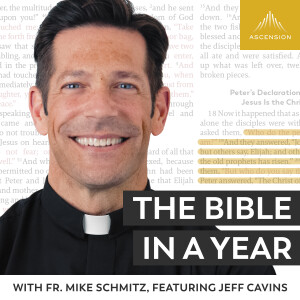

Join Tim and John as they talk about life and study John Chapter 20 Verses 1-31
Theme: https://uppbeat.io/t/northwestern/a-new-beginning
Transition Song: https://uppbeat.io/t/all-good-folks/
Introduction to John 20:1–31
From Grief to Glory: The Dawn of New Creation
The stone is rolled away. The tomb is empty.
John 20 takes us into the heart of the Christian faith—the resurrection of Jesus Christ. What began in sorrow at the cross now breaks into joyful astonishment as Jesus conquers death, confirms His identity, and commissions His followers.
This chapter is more than historical narrative—it is deeply personal and transformative. Each encounter with the risen Christ reveals a different kind of heart: the broken, the skeptical, the fearful. And in each case, Jesus meets them with grace, truth, and power.
Structure of John 20:- The Empty Tomb (vv. 1–10) – Discovery and confusion as the stone is rolled away and the body missing.
- Mary Magdalene Meets the Risen Christ (vv. 11–18) – A personal moment of recognition and renewal.
- Jesus Appears to the Disciples (vv. 19–23) – Fear turns to peace, and the Spirit is given.
- Thomas and the Power of Seeing (vv. 24–29) – Doubt is transformed into one of the most profound confessions of faith.
- John’s Purpose Statement (vv. 30–31) – The Gospel’s aim is clearly revealed:
“That you may believe… and have life in His name.”
- The Reality of the Resurrection – Not a symbol or myth, but a physical, witnessed event that changed history.
- The Personal Nature of Faith – Jesus calls people by name, invites touch, gives peace, and meets people in their doubts.
- The Birth of New Creation – The risen Christ begins a new era, breathing new life (symbolic of Genesis), commissioning disciples, and inaugurating Spirit-filled mission.
- Belief That Leads to Life – The resurrection demands a response—not just admiration, but belief that brings transformation.
- If John 19 is the payment, John 20 is the proof.
- Without the resurrection, the cross is a tragedy. With it, the cross becomes the triumph of God's love.
- This chapter invites every reader—whether broken like Mary, hesitant like Peter, or skeptical like Thomas—to encounter the risen Christ and believe.
"He is not here. He is risen."
This changes everything.
The grave couldn’t hold Him. Sin couldn’t defeat Him.
And now, He calls us to live in that same resurrection power.
The Stone Rolled Away, and Faith Awakening
The first sign of resurrection is not angels or trumpets—it’s an empty tomb. Quiet, confusing, and unexpected. For the earliest disciples, this wasn’t immediately joyful—it was perplexing, even alarming. But it was the beginning of a seismic shift: death had not won. Something unexplainable had happened… and hope was awakening.
1. Early Mourning Faithfulness (v. 1)“Now on the first day of the week Mary Magdalene came to the tomb early, while it was still dark…”
- Mary Magdalene, a devoted follower of Jesus, comes before dawn—while it’s still dark, both literally and emotionally.
- She finds the stone rolled away—a shocking sight, raising fears of grave robbery or desecration.
Reflection: Mary came expecting to mourn. But her grief would become the first step toward joy.
2. Panic and Assumption (v. 2)“They have taken the Lord out of the tomb, and we do not know where they have laid Him.”
- Mary immediately assumes the worst: that someone has stolen Jesus' body.
- She runs to tell Peter and “the other disciple” (likely John).
Insight: Resurrection wasn’t on their radar. Even those closest to Jesus struggled to believe at first.
3. A Race to the Tomb (vv. 3–4)“Peter and the other disciple went out toward the tomb. They both ran…”
- Peter and John sprint toward the tomb, showing urgency and desperation.
- John reaches the tomb first, but hesitates. Peter, true to character, rushes in.
Application: Our responses to mystery vary—some hesitate, some charge ahead. Jesus meets both.
4. What They Saw (vv. 5–7)“He saw the linen cloths lying there…”
- The burial cloths are still there, folded neatly. Not the scene of a grave robbery.
- The face cloth, in particular, is folded and separate—a deliberate act, not disorder or theft.
Symbolism: Jesus’ resurrection is not chaotic. It's ordered, calm, intentional. He is in control even over death.
5. Belief Begins to Dawn (v. 8)“Then the other disciple… also went in, and he saw and believed.”
- John enters the tomb after Peter. He sees the evidence—and believes.
- This is the first recorded moment of belief in the resurrection, though they still didn’t fully understand (v. 9).
Encouragement: Sometimes belief comes in stages. God honors growing faith, even when understanding is incomplete.
- A Quiet Return (v. 10)
“Then the disciples went back to their homes.”
- They leave still puzzled, but changed.
- The resurrection is real—but it hasn’t yet been revealed in full. That moment is still coming.
Character
Response
Lesson
Mary Magdalene
Grief and confusion
Grief can be the doorway to encounter
Peter
Bold and impulsive
God meets the restless and repentant
John
Observant and believing
God honors reflective, growing faith
Reflection Questions:
- What do I expect when I come to Jesus—grief, confusion, or hope?
- Am I willing to examine the evidence of His resurrection with open eyes?
- What might the “folded cloths” in my life be—those signs of His quiet, deliberate victory?
From Weeping to Witnessing: Love Recognizes the Lord
This passage captures the first recorded encounter with the risen Jesus—and it happens not with a king or a priest, but with a weeping woman. Mary Magdalene’s grief is deep, her love is unwavering, and her name is the first to be called by the resurrected Christ.
1. Grief That Lingers (vv. 11–13)“Mary stood weeping outside the tomb… She saw two angels… ‘Woman, why are you weeping?’”
- Mary remains after Peter and John leave. Her love keeps her rooted in grief.
- She sees two angels, seated like cherubim on the Ark, where Jesus’ body had been—pointing to divine presence and mercy.
- Despite their question, Mary can only repeat her assumption: “They have taken my Lord…”
Application: Sometimes love keeps us in the pain longer—but also positions us for deeper revelation.
2. Jesus Appears—but Isn’t Recognized (v. 14)“She turned around and saw Jesus standing, but she did not know that it was Jesus.”
- Jesus is there, alive—but Mary doesn't recognize Him. Possibly due to tears, shock, or divine restraint.
- This reflects a theme throughout the Gospels: resurrection is disorienting—not just physically, but spiritually.
Reflection: How often does Jesus stand near, and we don’t recognize Him in our sorrow?
3. The Personal Call (v. 16)“Jesus said to her, ‘Mary.’”
- One word changes everything—her name.
- With that, she knows. The Good Shepherd calls His sheep by name (John 10:3–4), and Mary responds instantly: “Rabboni!” (meaning “my Teacher”).
Theological Insight: Salvation is personal. The resurrection is not abstract—it calls us by name.
4. “Do Not Cling to Me” (v. 17)“Do not cling to Me, for I have not yet ascended…”
- Jesus gently redirects Mary. This is not a return to “how things were.” Something new is beginning.
- He points to His ascension—the completion of His mission and the coming of the Spirit.
- She is not to cling to the past, but to proclaim the future.
Missional Shift: The resurrection launches a movement. Mary is called not to hold, but to go and tell.
5. The First Witness (v. 18)“Mary Magdalene went and announced to the disciples, ‘I have seen the Lord!’”
- Mary becomes the first evangelist of the resurrection—a woman with a broken past now entrusted with the most glorious news.
- This overturns cultural expectations and affirms the Gospel’s radical inclusivity and grace.
Gospel Power: Jesus chooses the unlikely to carry His name. He speaks first to the loyal, the broken, the faithful—and sends them to others.
Summary: When Jesus Calls Your NameMoment
Meaning
Mary’s tears
Show her love and longing
Jesus’ question
Invites reflection and revelation
Her name
Sparks recognition and faith
His words
Redirect her from clinging to proclaiming
Her witness
Becomes the foundation of resurrection testimony
Reflection Questions:
- Am I lingering in sorrow without realizing Jesus is near?
- Do I recognize His voice calling my name in the middle of my grief?
- What is Jesus calling me to release, and what is He commissioning me to declare?
Peace, Presence, and Purpose in a Locked Room
From fear behind locked doors to being commissioned as ambassadors of grace—this moment marks a pivotal shift for the disciples. The risen Jesus comes not with rebuke, but with peace, proof, and power. What begins as a frightened gathering ends with the birth of a Spirit-empowered mission.
1. Behind Locked Doors (v. 19)“The doors were locked where the disciples were, for fear of the Jews…”
- Despite the news from Mary, the disciples are afraid—hiding, confused, unsure what to believe.
- They’re paralyzed by fear, grief, and guilt.
Application: Jesus doesn’t wait for us to get it together. He walks into locked rooms—even those sealed by fear.
2. Jesus Stands Among Them (v. 19b)“Jesus came and stood among them and said, ‘Peace be with you.’”
- No knock. No spectacle. Suddenly, He’s just there.
- His first words? Peace. Not judgment. Not rebuke.
- This is shalom—a divine, restoring peace that calms storms and mends broken spirits.
Reflection: The risen Christ brings peace—not by changing the world around us, but by entering into it.
3. Proof of Life (v. 20)“He showed them His hands and His side…”
- Jesus gives them evidence—He is not a ghost or a vision.
- The wounds remain, but they are no longer signs of defeat. They are marks of victory.
- The disciples rejoice—fear is replaced with joy.
Insight: Jesus doesn’t erase scars; He redeems them.
4. Repeated Peace and Renewed Purpose (v. 21)“Peace be with you. As the Father has sent Me, even so I am sending you.”
- He says “peace” again, confirming comfort and commission.
- They are being sent—just as He was sent. Their mission is now aligned with His mission.
Missional Shift: Resurrection is not the end of the story—it’s the beginning of the Church’s calling.
5. Receiving the Spirit (v. 22)“He breathed on them and said, ‘Receive the Holy Spirit.’”
- Echoes Genesis 2:7, where God breathed life into Adam. This is new creation.
- It foreshadows Pentecost—a symbolic empowering of what is to come.
- The disciples are now alive in a new way—filled with resurrection life.
Theological Insight: The same Spirit who raised Jesus now begins to dwell in His followers. New life. New breath. New mission.
6. The Authority of Forgiveness (v. 23)“If you forgive the sins of any, they are forgiven them…”
- This is not arbitrary power—it’s participation in Gospel proclamation.
- As representatives of Christ, the disciples will declare the message of forgiveness.
- This verse is about sharing the Gospel, not wielding personal judgment.
Key Understanding: The Church becomes a channel of God’s grace, not its gatekeeper.
Summary: From Fear to Faithful WitnessGift from Jesus
Purpose
Peace
To calm their troubled hearts
Presence
To prove He is truly alive
Purpose
To send them as ambassadors
Power (Spirit)
To equip them for the mission
Permission (Forgiveness)
To extend His grace to others
Reflection Questions:
- Where am I hiding behind locked doors of fear or doubt?
- How is Jesus breathing new life into me for mission today?
- Am I living like someone who has been sent?
From Doubt to Devotion: “My Lord and My God”
Thomas is often remembered as “the doubter,” but this moment is far deeper than skepticism. It is the story of a disciple who longed for real evidence, and who, when met with grace and truth, made one of the most profound confessions in Scripture. Jesus doesn’t shame him—He meets him, and invites him to faith that sees beyond sight.
1. The Absent Disciple (v. 24)“Now Thomas… one of the twelve, was not with them when Jesus came.”
- Thomas missed the first resurrection appearance. His absence leads to his doubt.
- Being disconnected from community left him vulnerable to disbelief.
Application: Faith struggles often grow in isolation. Stay near the fellowship of believers.
2. Skepticism and Conditional Belief (v. 25)“Unless I see… unless I touch… I will never believe.”
- Thomas sets his own terms for belief.
- He’s honest—but demanding. He wants proof of resurrection power in a wounded world.
Reflection: Thomas doesn’t ask for more than the others received. His words reflect a hurting heart seeking something solid.
3. Jesus Meets Him Where He Is (v. 26–27)“Then He said to Thomas, ‘Put your finger here… Do not disbelieve, but believe.’”
- One week later, Jesus comes again, specifically for Thomas.
- He quotes Thomas’ own words back to him—showing He heard even the unspoken doubt.
Insight: God is not afraid of your doubts. Jesus meets you in them, and gently leads you out of them.
4. The Greatest Confession (v. 28)“My Lord and my God!”
- Thomas doesn't need to touch. He sees Jesus and surrenders in faith.
- This is the most explicit statement of Jesus’ divinity in the Gospels.
Devotion: Doubt turned to worship. Thomas is not rebuked for questioning—he is celebrated for responding.
5. A Blessing for Future Believers (v. 29)“Blessed are those who have not seen and yet have believed.”
- Jesus affirms future disciples—that’s us.
- Faith is not less powerful because it lacks physical sight—it is blessed, because it trusts the testimony.
Encouragement: Your faith, though unseen, is not secondhand—it is part of Jesus’ plan all along.
Key Theme Five: The Purpose of the Book (John 20:30–31)Why John Wrote This Gospel: To Lead You to Life
John steps out of the narrative for a moment to tell us exactly why he wrote everything in this Gospel. It’s not just a biography—it’s an invitation.
1. A Selective Account (v. 30)“Now Jesus did many other signs… which are not written in this book.”
- John acknowledges that he didn’t record everything—Jesus’ life was too full.
- What’s included is intentional, not exhaustive.
Note: This Gospel isn’t just for curiosity—it’s curated for transformation.
2. That You May Believe (v. 31)“But these are written so that you may believe…”
- The goal is faith, not mere knowledge.
- Belief in what? That Jesus is the Christ, the Son of God.
Theological Focus: This echoes John’s opening: the Word became flesh. The purpose is to know Him, trust Him, follow Him.
3. And That You May Have Life (v. 31b)“…and that by believing you may have life in His name.”
- The result of belief isn’t just salvation from sin—it’s eternal life, abundant life, transformed life.
- This is the heartbeat of the Gospel: Jesus offers life, not just rules or religion.
Life Application: What we believe shapes how we live. Belief in Jesus births a life that reflects resurrection hope.
Summary: From Skepticism to WitnessPerson/Section
Response to Jesus
Lesson
Thomas
“My Lord and my God”
Doubt is welcomed, and transformed into worship.
You (the reader)
“That you may believe…”
The Gospel invites personal response and eternal life.
Reflection Questions:
- What doubts have I held back from bringing to Jesus?
- How can I grow in faith that doesn't rely on sight?
- Am I living the kind of life John envisioned—full of belief, and full of Christ’s life?
From the Empty Tomb to Full Hearts: The Victory That Changes Everything
John 20 takes us to the heart of the Gospel’s power—not just that Jesus died, but that He rose again, victorious over sin, death, and despair. It is a chapter filled with personal encounters, transformative moments, and faith that takes root in real lives.
From Mary Magdalene’s grief in the garden
to the disciples’ fear behind locked doors
to Thomas’ journey from doubt to worship—
every story shows us that the risen Jesus meets people right where they are.
Key Takeaways:
- The Resurrection Is Real
Jesus’ tomb was truly empty. His resurrected body bore the marks of the cross, but His life was unstoppable. He appeared, He spoke, He breathed, and He sent. - Faith Is Personal
He calls Mary by name. He shows His scars to Thomas. He breathes peace into fearful disciples. This is not a distant Messiah—it is a Savior who knows us and comes close. - Doubt Is Not Disqualifying
Thomas is not condemned for his skepticism. Jesus meets him in it. The path from doubt to belief is honored and sacred, and often leads to the deepest confession of faith. - We Are Sent
The risen Jesus breathes His Spirit on His followers and commissions them to proclaim forgiveness, peace, and new life. The resurrection is not just something to believe in—it’s a power to carry into the world. - This Gospel Has a Purpose
John wrote with you in mind—“that you may believe that Jesus is the Christ, the Son of God, and that by believing you may have life in His name.”
The resurrection of Jesus is not the end of His story—
it’s the beginning of ours.
It moves us from:
- Confusion to Clarity
- Fear to Faith
- Doubt to Devotion
- Death to Life
Now the question remains:
Do you believe?
Because believing changes everything.
More Episodes
All Episodes>>You may also like
Create Your Podcast In Minutes
- Full-featured podcast site
- Unlimited storage and bandwidth
- Comprehensive podcast stats
- Distribute to Apple Podcasts, Spotify, and more
- Make money with your podcast












